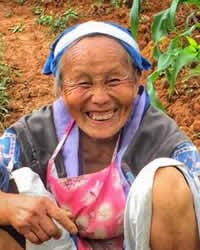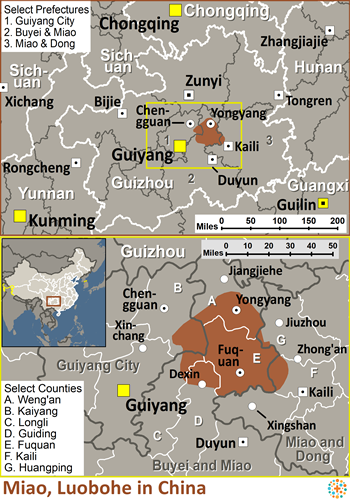The Hmong tribes (also known as the Miao) have a long history of resistance to the Chinese imperial authorities and endeavor to live separately from the Han Chinese, who called them "barbarians" and "dogs." For centuries, the Chinese have attempted to subjugate the various Hmong tribes. These attempts have instilled a quest for freedom deep within the hearts of the Hmong.
The Hmong tribes originated in China. However, during the 1800s, many immigrated to Vietnam, Thailand, Laos, and Myanmar. Over the years, they gradually expanded into approximately seventy to eighty separate groups, each with its own dialect, style of dress, and customs. Today, there are about one million Hmong speakers living in China, mostly in Guizhou Province. One of their subgroups is the Luobohe Miao. Most of what we say about them also applies to the other Hmong tribes.
The Luobohe Miao live in villages nestled high in the rocky mountain areas. Some are located several days walk from the nearest road. The Luobohe Miao economy is based on farming and raising draft animals such as cows or buffalo. The Luobohe Miao generally use the "slash and burn" method of agriculture on the mountain slopes. Those who live in the lower areas cultivate dry rice and maize. They also grow opium poppies as a cash crop. Those living at higher altitudes grow maize, millet, or buckwheat rather than rice. The children work alongside their parents in the fields.
A typical settlement contains from seven to fifty households arranged in a horseshoe pattern. They prefer their villages to be near a forest and a good source of water. Houses are usually built directly on the ground rather than on stilts. In some parts of China, the Hmong live in houses made of adobe or stone, similar to the homes of the Chinese. Poorer families construct their houses out of pieces of split bamboo and rough matting. Every house must face downhill, and no two houses may be in direct line with each other, since this might obstruct the pathway of the spirits.
Luobohe Miao society is divided into a number of patrilineal clans, which means that the line of descent is traced through the males. These clans freely intermarry. They permit polygyny, having multiple wives, although only the wealthiest men can afford to have second wives. Courtship is one of the main themes of the numerous Hmong festivals. Young couples often sing love songs to each other and exchange small gifts. In most cases young people are free to select their own mates. A newlywed couple usually lives with the groom's family until the birth of their first child. At that time, the young couple moves into their own home.
The most important social units are the family and the clan (extended family). Within the extended family, the oldest male has virtually unlimited authority. Some households are nuclear, while others are extended, ranging from one to twenty-five members.
The Hmong are well known for their songs and dances. Although they have no full-time craftsmen, they are famous for their silver work, embroidery, and intricate needlework.
The Hmong practice their own ethnic religion, which involves the worship of demons, spirits of nature, and ancestral spirits. There are many "household spirits," which they believe protect them from disease and death, and watch over their crops, money, and livestock. They appease these spirits through animal sacrifices and the burning of "paper money." Every village has at least one Shaman (witchdoctor) who is used to exorcise evil spirits. Prescribed methods and procedures govern everything from individual behavior to the locations of their homes and villages.
An important role of the shaman is to consult the spirits regarding where a new home should be located. They chose this location with great care. Each home is built to accommodate the spirits. Luobohe homes contain at least one altar for acknowledging and appeasing the ancestral spirits. The Luobohe Miao homes maintain a clear path from the doorway to the altar so as not to hinder the spirits from approaching the altar. In the same way, houses must not be built in direct line with each other to enable the spirits to move about freely in and around the houses.
The majority of the Luobohe Miao have not heard a clear presentation of the gospel. Witness to them is difficult, however, because missionary activity in China is restricted. Prayer is the key to seeing them reached with the gospel that can truly set them free.
Pray for the Lord to provide for the Luobohe Miao's physical and spiritual needs and that they will understand this as an example of God's grace and mercy.
Pray for the Lord to thrust out Holy Spirit-anointed workers to the Luobohe Miao people.
Pray that they will have a thirst for the water of life that only Jesus can provide.
Pray for a movement to Christ that cannot be stopped.
Scripture Prayers for the Miao, Luobohe in China.
| Profile Source: Joshua Project |

























